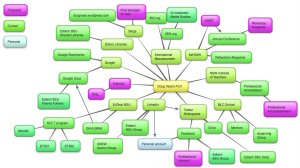In this week’s post I’m submitting an annotated bibliography for EdTech501 of some research papers I discovered a little while ago. I was meant to copy them here to my Learning Log after sharing them in Google Docs and must have forgot. I hope you enjoy them. =)
Bates, A. W., & Poole, G. (2003). Effective teaching with technology in higher education: Foundations for success (1st ed.). Jossey-Bass.
The central theme of this book is well encapsulated by the title. This book is written for teachers at the higher (tertiary) education level by an academic consultant and fellow teacher both of whom have extensive international experience in the field of educational technology. The aim of this book is to assist instructors to make the best use of technology for teaching in post-secondary education. To do this, the book explores the fundamental educational and organizational principles that should drive the use of technology for teaching. It is based on the assumption that inevitably we will all need to use technology in the classroom and addresses how educators can best use it for teaching and effective learning. The book is formatted in three sections covering (i) the fundamentals of educational technology, (ii) the design and development of courses and their delivery, and (iii) the issues associated with the rapid change and delivery formats with technology. The book does more than illuminate the importance of integrating technology in the classroom because it goes one step further by providing strategies and principles for delivering courses using electronic technology.
Filsell, J., & Barnes, A. (2002). Researching pedagogy and teaching methodologies that transform student learning in South Australian classrooms. In Proceedings of the Seventh world conference on computers in education conference on Computers in education: Australian topics, 8, p30, Retrieved from http://portal.acm.org/citation.cfm?id=820065
This paper reports on the systematic research program to investigate learning outcomes in the context of the Learning Technologies Project (1999–2001) of the South Australian Department for Education, Training and Employment. The research addresses three areas: student learning, teacher methodologies and school structures. It uses both student and teacher surveys and records positive interim findings as paradigmatic. It illustrates almost all the important and necessary factors required for successful integration of educational technology. From embedding it directly in the curriculum as opposed to stand alone and a greater need for understanding the constructivist approach through to the requirement for ongoing teacher professional development.
Hayes, D. N. (2007). ICT and learning: Lessons from Australian classrooms. Computers & Education, 49(2), 385–395.
This qualitative research report details several NSW schools transitions with ICT in the classroom and the shifts that both teachers and students have observed. A range of schools were selected who were already actively pursuing an educational technology strategy. Via both interviews and observations it was discovered that the most significant positive impacts of integrating technology is that teachers have become facilitators in a more student centred learning environment. Whole school ICT integration strategies were also preferred and both teacher professional development along with leadership in educational technology were highlighted as essential elements for successful integration. Simply substituting technology for current resources like a textbook or whiteboard were insufficient and ineffective. Teachers must consider the pedagogical aspects of integrating educational technology and make the required changes to be successful.
Plowman, L., & Stephen, C. (2003). A ‘benign addition’? Research on ICT and pre-school children. Journal of Computer Assisted Learning, 19(2), 149–164.
This paper reviews the international research evidence for teaching pre-school students with ICT. It addresses the concept of a ‘benign addition’ where technology is simply a supplement to existing resources and is not being used to transform learning practices. The authors are academics and conducted quantitative review of research to determine current ICT practices for the pre-school classroom. They discovered a melting pot of issues from anti-technology movements who claim it is affecting childhood health through to predicting that the future interface of touch screen devices will revolutionise edtech at this level.
Ringstaff, C., & Kelley, L. (2002). The learning return on our educational technology investment. Retrieved April, 8, 2004.
First paragraph says it all, technology is a means not an end. This report addresses this issue head on and tackles the key issues of what makes ‘smart’ and ‘effective’ uses of technology. They outline how neither hardware or software make educational technology work but that a trained teacher in the field of EdTech makes her students better learners. There is limited information about the authors but the intended audience is government or educational boards.
Singh, H. (2003). Building effective blended learning programs. Educational Technology – Saddle Brook then Englewood Cliffs NJ-, 43(6), 51–54.
This paper outlines a possible framework for blended learning. A standardised framework is useful as it can help to develop standards across a field. This article has most of its research based in the adult workplace or with higher ed learners and not K-12. It clearly explains the problems and challenges experienced by purely online mediums for edtech and justifies Blended Learning as the best of both worlds.

